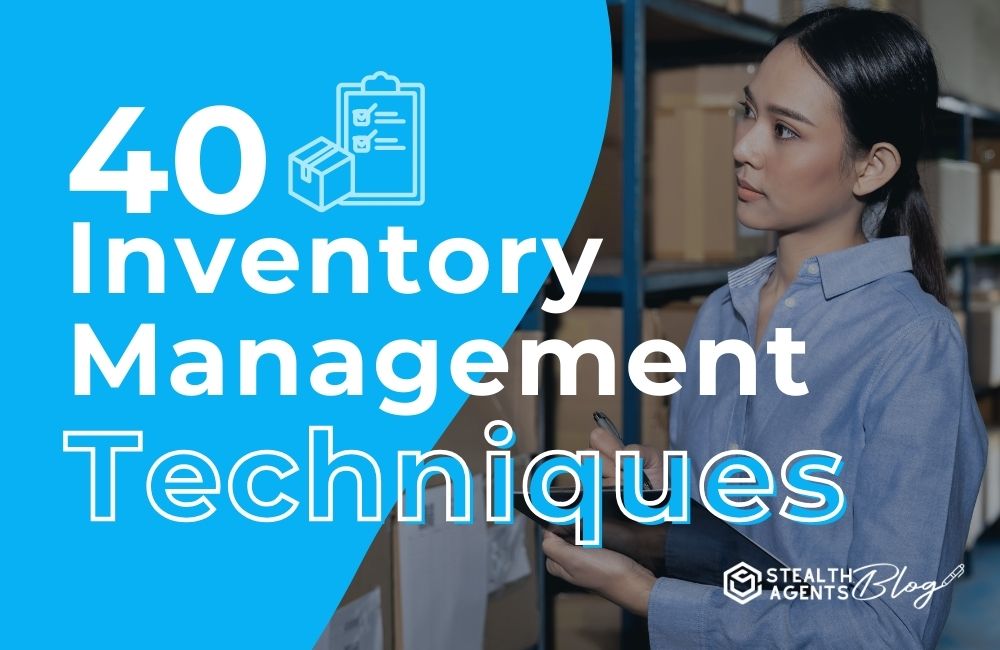Mastering inventory management techniques is crucial for businesses aiming to thrive in today’s competitive market, where effective techniques of inventory management can make a significant difference.
Remarkably, companies that excel in inventory management methods can reduce carrying costs by up to 25%, unlocking significant savings that directly impact their bottom line.
From techniques of inventory to enhancing supply chain efficiency, these strategies streamline operations, improve customer satisfaction, and boost profitability.
Moreover, businesses that implement effective techniques for inventory management see a 50% improvement in order fulfillment rates, underscoring the value of refined processes and inventory management outsourcing.
As you explore these 40 innovative methods, consider how Stealth Agents can elevate your practices with expert insights, offering solutions through professional remote assistants and startup funding ideas.
They provide free consultations to tailor virtual assistant solutions to your specific needs and preferences, with transparent virtual assistant pricing.
What is Inventory Management Techniques?
Inventory management techniques can vary based on several factors, including the type of products being sold, the size and structure of the business, and its supply chain capabilities.
*advertisement*
Tired & Overwhelmed With Administrative Tasks?
Hire A Top 1% Virtual Assistant From Stealth Agents!

Sign Up Below & Hire A Top 1% Virtual Assistant
Rated 4.7 Stars Serving Over 2,000+ Customers.
Hire Top 1% Virtual Assistants For $10-$15 Per Hour
Ask About Our 14 Day Trial!
*advertisement*
Other factors that may influence the choice of inventory management technique include:
1. Business Goals and Objectives
The goals and objectives of a business may affect which types of inventory management techniques are most suitable.
For example, a small business with limited storage space may prioritize cost-reduction initiatives, while a larger company with a broader product range may focus on optimizing stock levels.
Understanding a business’s specific needs can help select the most effective inventory management techniques, ensuring that they align with the company’s strategic goals.
Additionally, employing a virtual or online personal assistant can streamline inventory processes by handling tasks to outsource to virtual assistant, such as data entry and stock monitoring.
This approach incorporates various inventory planning techniques for managing inventory and enhances efficiency by leveraging advanced techniques of inventory control that cater to different business objectives.
2. Product Demand and Seasonality
The level of product demand can influence the choice of inventory management technique.
For example, businesses with high-demand products may benefit from using just-in-time methods of inventory management to avoid overstocking.
In contrast, those with seasonal products may need to use techniques that can handle fluctuations in demand.
Effective techniques of inventory management can significantly impact a business’s ability to meet consumer needs efficiently.
Incorporating advanced techniques for inventory management, such as utilizing a virtual assistant, can streamline operations and optimize resource allocation.
By exploring various inventory management techniques, businesses can adopt the most suitable inventory management methods to enhance their overall performance and adapt to market changes.
3. Supply Chain Capabilities
The efficiency and reliability of a business’s supply chain can also impact which inventory management techniques are most effective.
For example, companies with strong supplier partnerships and quick delivery times may benefit from vendor-managed inventory or cross-docking.
In contrast, those with less reliable suppliers may need to have safety stock management techniques.
Incorporating advanced techniques of inventory management, such as using a virtual assistant, can further streamline operations by automating routine tasks and providing real-time data analysis.
Businesses seeking to optimize their inventory management methods might explore various techniques to find the best fit for their specific needs.
By understanding and applying diverse techniques of inventory, a company can enhance its ability to respond swiftly to market demands and minimize potential disruptions.
4. Cost Considerations
Different inventory management techniques have varying costs, such as setup, holding, and ordering costs.
Businesses must consider these costs when deciding which method is the most cost-effective for their specific needs and goals.
By evaluating the techniques of inventory management, companies can identify which processes align best with their operational strategies.
Techniques for inventory management, like just-in-time or ABC analysis, offer distinct advantages and challenges, impacting overall efficiency and cost.
Incorporating a virtual assistant into your inventory strategy can further streamline these processes, allowing for better tracking and analysis of inventory management methods.
Ultimately, understanding and applying the proper techniques of inventory ensures that businesses maintain optimal stock levels while minimizing expenses.
5. Technological Capabilities
Advancements in technology have also led to the development of more advanced inventory management techniques, such as RFID and barcode scanning.
Businesses with the necessary technological capabilities may implement these techniques for more accurate and efficient inventory management.
Additionally, virtual assistants are becoming integral to inventory management, streamlining operations, and enhancing techniques in inventory management by reducing manual errors.
As these inventory management methods evolve, companies are continually seeking new techniques to stay competitive and ensure that their techniques remain cutting-edge.
6. Regulatory Requirements
For businesses dealing with regulated goods, such as pharmaceuticals or food products, lot tracking and FEFO methods may be necessary to ensure compliance with regulations.
These businesses must consider regulatory requirements when choosing their inventory management techniques.
Implementing advanced techniques of inventory management can significantly enhance accuracy and compliance, reducing the risk of regulatory issues.
Additionally, employing a virtual assistant can streamline various techniques for inventory management, allowing businesses to focus on optimizing their inventory management methods.
By leveraging these innovative techniques of inventory, companies can achieve greater efficiency and maintain high standards in their operational processes.
Lists of Inventory Management Techniques
1. Just-in-time (JIT) inventory system
This method strategically lowers inventory levels by ordering products based solely on actual demand, effectively minimizing excess stock.
Consequently, businesses can significantly reduce storage costs and enhance cash flow efficiency, ensuring resources are optimally allocated and operational flexibility is increased.
2. ABC analysis
This system categorizes inventory into three classes: A for high-value items, B for moderate-value items, and C for low-value items.
By prioritizing resources and focus on A items, businesses enhance efficiency, optimize stock levels, and minimize holding costs.
3. Economic Order Quantity
This technique involves calculating the ideal product order quantity by balancing ordering and carrying inventory costs.
By optimizing these costs, businesses can improve operational efficiency, reduce unnecessary expenses, and ensure a more streamlined inventory management process.
4. Drop-shipping
In this model, a third-party seller manages and holds the inventory, streamlining operations by directly shipping products to customers.
This eliminates the business’s need for on-site storage, reducing overhead costs and simplifying supply chain logistics, ultimately enhancing efficiency and customer satisfaction.
5. Cross-docking
Incoming shipments are efficiently sorted upon arrival and swiftly routed to outbound trucks for immediate delivery.
This streamlined process minimizes storage time, enhances delivery speed, and ensures products reach their destinations faster, ultimately improving operational efficiency and customer satisfaction through timely, reliable service.
6. Vendor-managed inventory (VMI)
The techniques for supplier inventory management are responsible for monitoring and managing inventory levels directly at the customer’s location, ensuring timely restocking.
This proactive approach minimizes stockouts and optimizes inventory turnover, allowing customers to focus on core business activities without worrying about supply chain disruptions.
7. Just-in-sequence (JIS) delivery
Delivering products in a specific sequence is crucial to enhancing production efficiency by minimizing downtime and optimizing workflow.
This strategic sequencing ensures each production stage receives necessary components in time, facilitating seamless operations and maximizing productivity across the manufacturing process.
8. Consignment inventory
By retaining ownership of inventory until it is sold, the supplier alleviates the financial burden and minimizes the buyer’s risk.
This arrangement reduces upfront costs, enhances cash flow, and protects the buyer from potential losses associated with unsold or obsolete stock.
9. Safety stock
Extra inventory is a crucial buffer to protect against unexpected demand spikes or supply chain disruptions.
By maintaining additional stock, businesses can ensure seamless operations, avoid potential sales losses, and enhance customer satisfaction by meeting orders promptly.
10. RFID technology
Radio-frequency identification (RFID) tags enable businesses to track inventory in real-time, significantly enhancing the accuracy and efficiency of inventory management.
By providing precise location data, RFID systems streamline operations, minimize errors, and optimize stock levels, ultimately boosting overall productivity.
11. Kanban system
A visual signal system, such as Kanban, is implemented in inventory management to trigger production or reorder stock when needed efficiently.
This method enhances operational efficiency by minimizing overproduction, reducing inventory waste, and ensuring timely availability of essential materials.
12. First-in, first-out (FIFO) method
By prioritizing the sale of the oldest inventory, businesses effectively minimize the risk of spoilage or obsolescence, ensuring that products reach consumers before expiration.
This practice optimizes inventory turnover, reduces waste, and enhances profitability by maximizing product use and maintaining quality.
13. Last-in, first-out (LIFO) method
Selling the newest inventory first, known as FIFO, can lower tax liabilities as taxes are based on older, cheaper inventory costs.
However, during inflationary periods, it may result in inflated profits, potentially affecting financial statements and misleading stakeholders.
14. Perpetual inventory system
Inventory levels are meticulously managed by consistently monitoring and recording each transaction involving incoming and outgoing products.
This ongoing process ensures accuracy and efficiency, helping businesses maintain optimal stock levels, reduce the risk of shortages, prevent overstocking, and improve overall operational effectiveness.
15. Periodic inventory system
Inventory levels are updated only during periodic physical counts, necessitating significant manual effort.
This approach can lead to inaccuracies, inefficiencies, and delayed data, resulting in potential stock discrepancies and challenges in maintaining the correct balance between supply and demand for businesses.
16. Stock review
Regular evaluation of inventory levels, coupled with timely adjustments based on fluctuating demand patterns, is crucial for businesses.
This proactive approach helps to align stock with market trends, enhances responsiveness, minimizes excess inventory, and optimizes overall inventory management for improved profitability and customer satisfaction.
17. Safety lead time
The additional time is strategically integrated into the ordering process to address potential delays or errors proactively.
This thoughtful approach ensures smoother operations by providing a buffer for unforeseen issues, ultimately enhancing customer satisfaction and maintaining reliable service delivery and efficiency.
18. Economic lead time
19. Carrying costs
The costs associated with storing and handling inventory encompass a variety of expenses, including the price of storage space, labor for managing stock, insurance premiums for safeguarding goods, and other related expenditures.
These factors significantly influence overall inventory management costs.
20. Stock holding cost
Maintaining excessive inventory can lead to significant financial and operational drawbacks, including increased risks of spoilage and obsolescence, higher storage costs, and a negative impact on cash flow.
This situation ultimately reduces profitability and hampers a company’s financial health.
21. Ordering costs
Placing an order for new inventory involves various costs, including administrative fees for processing orders and transportation expenses for shipping goods.
These costs significantly impact overall expenses, with potential additional charges such as handling fees, taxes, and storage costs further affecting procurement budgets.
22. Reorder point
The minimum inventory level is a critical threshold in inventory management, dictating when new orders must be placed to prevent stockouts.
By maintaining this level, businesses ensure a continuous supply of products, supporting smooth operations and customer satisfaction through timely reordering.
23. Lead time demand
The required inventory amount during the lead time is crucial for seamless operations.
Accurately calculating this ensures businesses can meet customer demand without delays, preventing stockouts and maintaining satisfaction.
Proper inventory management helps keep operations smooth and customers content.
24. Stockout costs
Running out of stock can lead to missed sales opportunities and tarnish customer relationships, resulting in financial setbacks.
This underscores the importance of maintaining adequate inventory levels to ensure consistent product availability and safeguard revenue and customer satisfaction.
25. Service Level
The capacity to meet demand with existing stock is crucial for ensuring customer satisfaction and maintaining smooth operations.
With sufficient inventory, businesses can promptly fulfill customer needs, avoid supply chain delays, and enhance overall service efficiency and reliability.
26. Carrying cost percentage
The proportion of carrying costs to total inventory value is crucial in determining optimal inventory levels.
By analyzing this ratio, businesses can balance holding costs and inventory, ensuring efficient operations and maximizing profitability through improved resource allocation and reduced excess stock.
27. Stock turnover rate
Inventory turnover, reflected by the frequency of selling and replenishing stock over a set period, is a crucial indicator of effective inventory management.
High turnover rates demonstrate efficient practices, directly enhancing business profitability and overall operational efficiency.
28. Deadstock reduction
To effectively minimize excess or obsolete inventory, businesses can implement targeted promotions to boost demand, offer strategic discounts to accelerate sales, and responsibly dispose of unsellable stock.
These measures help maintain balanced inventory levels and reduce financial losses.
29. FIFO/LIFO layering
Accounting methods are crucial in meticulously tracking inventory and accurately determining its value.
They are also essential for precise financial reporting and informed decision-making, enabling businesses to assess performance, ensure compliance, and strategize effectively to enhance operational success.
30. Stock aging analysis
Examining the age of products helps identify items that are not selling well, enabling businesses to mark down or remove them from the market strategically.
This proactive approach optimizes inventory, enhances sales performance, and prevents unnecessary stock accumulation.
31. Inventory forecasting
Predicting future demand involves analyzing historical sales data and observing current market trends.
This strategic approach allows businesses to adjust product levels accurately, ensuring they meet customer needs efficiently, prevent stockouts, minimize excess inventory, and enhance overall supply chain management and customer satisfaction.
32. Continuous replenishment
Continuous monitoring and restocking of inventory are crucial for maintaining optimal stock levels.
This practice ensures businesses can enhance efficiency, prevent stockouts, and support smooth operations, ultimately improving customer satisfaction and better resource management for sustainable growth.
33. Stock pooling
Combining inventory from multiple locations streamlines operations by optimizing product usage and reducing overall stock levels significantly.
This strategy enhances efficiency in inventory management across different sites, ensuring that resources are utilized effectively and reducing excess stock and associated carrying costs.
34. Multi-echelon inventory optimization (MEIO)
Strategies leveraging data and technology focus on optimizing inventory management across multiple distribution centers or suppliers.
These approaches enhance efficiency, reduce operational costs, and improve coordination within the supply chain, ensuring timely product availability while minimizing excess inventory and associated expenses.
35. SKU rationalization
Analyzing individual product performance involves assessing sales trends, customer feedback, and profitability metrics to decide which items to keep or discontinue.
This strategic evaluation helps businesses optimize inventory, enhance product offerings, and maximize profitability by aligning with market demand.
36. Cycle counting
Regularly scheduled physical inventory counts are crucial for maintaining accuracy in inventory records.
These assessments help identify and rectify discrepancies, ensuring reliable data.
This practice enhances effective inventory management, supports operational efficiency, and minimizes potential losses due to inventory errors or miscounts.
37. Inventory audits
Conducting comprehensive inventory management processes and systems reviews is crucial for identifying improvement areas.
This practice enhances efficiency by pinpointing weaknesses, streamlining operations, optimizing overall inventory control, ensuring resources are utilized effectively, and reducing unnecessary costs and inefficiencies.
38. Collaborative planning, forecasting, and replenishment (CPFR)
Sharing demand and inventory information among supply chain partners enhances collaboration and transparency, improving efficiency and cost reduction.
This strategic exchange ensures better resource allocation, swift response to market changes, and optimized inventory management, ultimately boosting overall supply chain performance.
39. Virtual Inventory
Technologies like 3D printing and virtual warehousing revolutionize inventory management by minimizing physical stock levels.
These innovations reduce storage expenses, enhance operational flexibility, and boost supply chain efficiency, enabling businesses to adapt swiftly to market demands and optimize resource allocation.
40. Just-in-case (JIC) inventory
Maintaining additional inventory is a crucial buffer against unforeseen supply chain disruptions, ensuring business continuity.
This proactive approach allows companies to swiftly meet customer demands despite unexpected events, safeguarding against potential delays and maintaining reliable service levels under challenging circumstances.
Takeaways
Mastering inventory management techniques is essential for optimizing business operations and ensuring sustainable growth.
These techniques help maintain the right balance of stock, enhance efficiency, and reduce costs.
By implementing the proper inventory management methods, businesses can streamline their supply chain processes and improve customer satisfaction.
It’s crucial to stay updated with the evolving inventory techniques to tackle challenges effectively.
Leveraging technology and data analytics plays a significant role in refining these techniques for better outcomes.
Understanding the nuances of different techniques of inventory management can empower companies to make informed decisions that drive success.
Adopting these inventory management methods can provide a significant edge as the business landscape becomes increasingly competitive.
To further enhance your inventory management efficiency, consider utilizing the expertise of a virtual assistant from Stealth Agents, who can tailor these techniques to your specific needs and boost your operational excellence.










